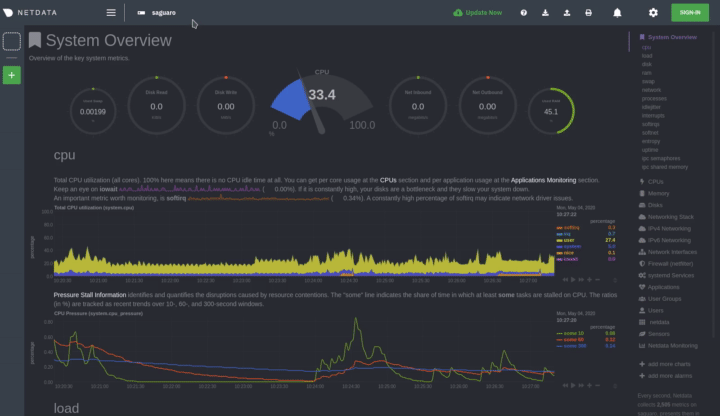diff options
Diffstat (limited to 'docs/configure/nodes.md')
| -rw-r--r-- | docs/configure/nodes.md | 121 |
1 files changed, 121 insertions, 0 deletions
diff --git a/docs/configure/nodes.md b/docs/configure/nodes.md new file mode 100644 index 0000000000..5998c1e746 --- /dev/null +++ b/docs/configure/nodes.md @@ -0,0 +1,121 @@ +<!-- +title: "Configure your nodes" +description: "Netdata is zero-configuration for most users, but complex infrastructures may require you to tweak some of the Agent's granular settings." +custom_edit_url: https://github.com/netdata/netdata/edit/master/docs/configure/nodes.md +--> + +# Configure your nodes + +Netdata's zero-configuration collection, storage, and visualization features work for many users, infrastructures, and +use cases, but there are some situations where you might want to configure your nodes. + +For example, you might want to increase metrics retention, configure a collector based on your infrastructure's unique +setup, or secure the local dashboard by restricting it to only connections from `localhost`. + +Whatever the reason, Netdata users should know how to configure individual nodes to act decisively if an incident, +anomaly, or change in infrastructure affects how their Agents should peform. + +## The Netdata config directory + +On most Linux systems, using our [recommended one-line installation](/docs/get/README.md#install-the-netdata-agent), the +**Netdata config directory** is `/etc/netdata/`. The config directory contains several configuration files with the +`.conf` extension, a few directories, and a shell script named `edit-config`. + +> Some operating systems will use `/opt/netdata/etc/netdata/` as the config directory. If you're not sure where yours +> is, navigate to `http://NODE:19999/netdata.conf` in your browser, replacing `NODE` with the IP address or hostname of +> your node, and find the `# config directory = ` setting. The value listed is the config directory for your system. + +All of Netdata's documentation assumes that your config directory is at `/etc/netdata`, and that you're running any +scripts from inside that directory. + +## Netdata's configuration files + +Upon installation, the Netdata config directory contains a few files and directories. + +- `netdata.conf` is the main configuration file. This is where you'll find most configuration options. This doc won't + go into exhaustive detail about each setting. You can read descriptions for each in the [daemon config + doc](/daemon/config/README.md). +- `orig` is a symbolic link to the directory `/usr/lib/netdata/conf.d`, which contains stock configuration files. + Stock versions are copied into the config directory when opened with `edit-config`. _Do not edit the files in + `/usr/lib/netdata/conf.d`, as they are overwritten by updates to the Netdata Agent._ +- `edit-config` is a shell script used for [editing configuration files](#use-edit-config-to-edit-netdataconf). +- `go.d/`, `python.d/`, `charts.d/`, `node.d`/, and `custom-plugins.d/`, which are directories for each of Netdata's + [orchestrators](/collectors/plugins.d/README.md#external-plugins-overview). These directories can each contain + additional `.conf` files for configuring specific collectors. + +## Use `edit-config` to edit `netdata.conf` + +The best way to edit any configuration file is with `edit-config` script. This script opens existing Netdata +configuration files using your system's `$EDITOR`. If the file doesn't yet exist in your config directory, the script +copies the stock version from `/usr/lib/netdata/conf.d` and opens it for editing. + +`edit-config` is the recommended way to easily and safely edit Netdata's configuration. + +Run `edit-config` without any options to see details on its usage and a list of all the configuration files you can +edit. + +```bash +./edit-config +USAGE: + ./edit-config FILENAME + + Copy and edit the stock config file named: FILENAME + if FILENAME is already copied, it will be edited as-is. + + The EDITOR shell variable is used to define the editor to be used. + + Stock config files at: '/usr/lib/netdata/conf.d' + User config files at: '/etc/netdata' + + Available files in '/usr/lib/netdata/conf.d' to copy and edit: + +./apps_groups.conf ./health.d/phpfpm.conf +./aws_kinesis.conf ./health.d/pihole.conf +./charts.d/ap.conf ./health.d/portcheck.conf +./charts.d/apcupsd.conf ./health.d/postgres.conf +... +``` + +To edit `netdata.conf`, run `./edit-config netdata.conf`. You may need to elevate your privileges with `sudo` or another +method for `edit-config` to write into the config directory. Use your `$EDITOR`, make your changes, and save the file. + +> `edit-config` uses the `EDITOR` environment variable on your system to edit the file. On many systems, that is +> defaulted to `vim` or `nano`. To change this variable for the current session (it will revert to the default when you +> reboot), export a new value: `export EDITOR=nano`. Or, [make the change +> permanent](https://stackoverflow.com/questions/13046624/how-to-permanently-export-a-variable-in-linux). + +After you make your changes, you need to restart the Agent with `service netdata restart`. + +Here's an example of editing the node's hostname, which appears in both the local dashboard and in Netdata Cloud. + + + +### Other configuration files + +You can edit any Netdata configuration file using `edit-config`. A few examples: + +```bash +./edit-config apps_groups.conf +./edit-config ebpf.conf +./edit-config health.d/load.conf +./edit-config go.d/prometheus.conf +``` + +The documentation for each of Netdata's components explains which file(s) to edit to achieve the desired behavior. + +## What's next? + +Take advantage of this newfound understanding of node configuration to [add security to your +node](/docs/configure/secure-nodes.md). We have a few best practices based on how you use the Netdata Agent and Netdata +Cloud. + +You can also take what you've learned about node configuration to tweak the Agent's behavior or enable new features: + +- [Enable new collectors](/docs/collect/enable-configure.md) or tweak their behavior. +- [Configure existing health alarms](/docs/monitor/configure-alarms.md) or create new ones. +- [Enable notifications](/docs/monitor/enable-notifications.md) to receive updates about the health of your + infrastructure. +- Change [the long-term metrics retention period](/docs/store/change-metrics-storage.md) using the database engine. + +[](<>) |
